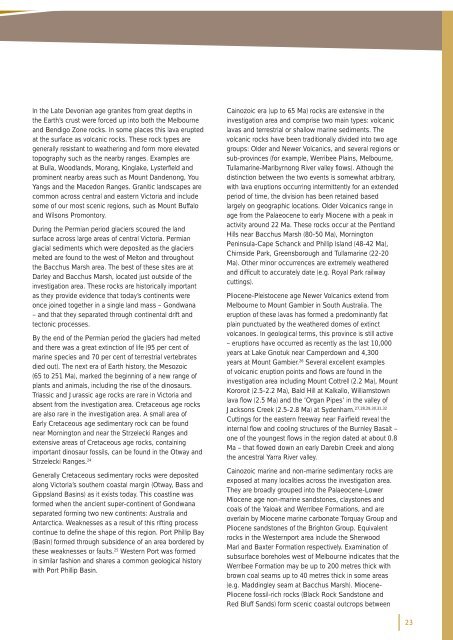Metropolitan Melbourne Investigation Discussion Paper - Victorian ...
Metropolitan Melbourne Investigation Discussion Paper - Victorian ...
Metropolitan Melbourne Investigation Discussion Paper - Victorian ...
You also want an ePaper? Increase the reach of your titles
YUMPU automatically turns print PDFs into web optimized ePapers that Google loves.
In the Late Devonian age granites from great depths in<br />
the Earth’s crust were forced up into both the <strong>Melbourne</strong><br />
and Bendigo Zone rocks. In some places this lava erupted<br />
at the surface as volcanic rocks. These rock types are<br />
generally resistant to weathering and form more elevated<br />
topography such as the nearby ranges. Examples are<br />
at Bulla, Woodlands, Morang, Kinglake, Lysterfi eld and<br />
prominent nearby areas such as Mount Dandenong, You<br />
Yangs and the Macedon Ranges. Granitic landscapes are<br />
common across central and eastern Victoria and include<br />
some of our most scenic regions, such as Mount Buffalo<br />
and Wilsons Promontory.<br />
During the Permian period glaciers scoured the land<br />
surface across large areas of central Victoria. Permian<br />
glacial sediments which were deposited as the glaciers<br />
melted are found to the west of Melton and throughout<br />
the Bacchus Marsh area. The best of these sites are at<br />
Darley and Bacchus Marsh, located just outside of the<br />
investigation area. These rocks are historically important<br />
as they provide evidence that today’s continents were<br />
once joined together in a single land mass – Gondwana<br />
– and that they separated through continental drift and<br />
tectonic processes.<br />
By the end of the Permian period the glaciers had melted<br />
and there was a great extinction of life (95 per cent of<br />
marine species and 70 per cent of terrestrial vertebrates<br />
died out). The next era of Earth history, the Mesozoic<br />
(65 to 251 Ma), marked the beginning of a new range of<br />
plants and animals, including the rise of the dinosaurs.<br />
Triassic and Jurassic age rocks are rare in Victoria and<br />
absent from the investigation area. Cretaceous age rocks<br />
are also rare in the investigation area. A small area of<br />
Early Cretaceous age sedimentary rock can be found<br />
near Mornington and near the Strzelecki Ranges and<br />
extensive areas of Cretaceous age rocks, containing<br />
important dinosaur fossils, can be found in the Otway and<br />
Strzelecki Ranges. 24<br />
Generally Cretaceous sedimentary rocks were deposited<br />
along Victoria’s southern coastal margin (Otway, Bass and<br />
Gippsland Basins) as it exists today. This coastline was<br />
formed when the ancient super-continent of Gondwana<br />
separated forming two new continents: Australia and<br />
Antarctica. Weaknesses as a result of this rifting process<br />
continue to defi ne the shape of this region. Port Phillip Bay<br />
(Basin) formed through subsidence of an area bordered by<br />
these weaknesses or faults. 25 Western Port was formed<br />
in similar fashion and shares a common geological history<br />
with Port Phillip Basin.<br />
Cainozoic era (up to 65 Ma) rocks are extensive in the<br />
investigation area and comprise two main types: volcanic<br />
lavas and terrestrial or shallow marine sediments. The<br />
volcanic rocks have been traditionally divided into two age<br />
groups: Older and Newer Volcanics, and several regions or<br />
sub-provinces (for example, Werribee Plains, <strong>Melbourne</strong>,<br />
Tullamarine-Maribyrnong River valley fl ows). Although the<br />
distinction between the two events is somewhat arbitrary,<br />
with lava eruptions occurring intermittently for an extended<br />
period of time, the division has been retained based<br />
largely on geographic locations. Older Volcanics range in<br />
age from the Palaeocene to early Miocene with a peak in<br />
activity around 22 Ma. These rocks occur at the Pentland<br />
Hills near Bacchus Marsh (80-50 Ma), Mornington<br />
Peninsula-Cape Schanck and Phillip Island (48-42 Ma),<br />
Chirnside Park, Greensborough and Tullamarine (22-20<br />
Ma). Other minor occurrences are extremely weathered<br />
and diffi cult to accurately date (e.g. Royal Park railway<br />
cuttings).<br />
Pliocene-Pleistocene age Newer Volcanics extend from<br />
<strong>Melbourne</strong> to Mount Gambier in South Australia. The<br />
eruption of these lavas has formed a predominantly fl at<br />
plain punctuated by the weathered domes of extinct<br />
volcanoes. In geological terms, this province is still active<br />
– eruptions have occurred as recently as the last 10,000<br />
years at Lake Gnotuk near Camperdown and 4,300<br />
years at Mount Gambier. 26 Several excellent examples<br />
of volcanic eruption points and fl ows are found in the<br />
investigation area including Mount Cottrell (2.2 Ma), Mount<br />
Kororoit (2.5-2.2 Ma), Bald Hill at Kalkallo, Williamstown<br />
lava fl ow (2.5 Ma) and the ‘Organ Pipes’ in the valley of<br />
Jacksons Creek (2.5-2.8 Ma) at Sydenham. 27,28,29,30,31,32<br />
Cuttings for the eastern freeway near Fairfi eld reveal the<br />
internal fl ow and cooling structures of the Burnley Basalt –<br />
one of the youngest fl ows in the region dated at about 0.8<br />
Ma – that fl owed down an early Darebin Creek and along<br />
the ancestral Yarra River valley.<br />
Cainozoic marine and non-marine sedimentary rocks are<br />
exposed at many localities across the investigation area.<br />
They are broadly grouped into the Palaeocene-Lower<br />
Miocene age non-marine sandstones, claystones and<br />
coals of the Yaloak and Werribee Formations, and are<br />
overlain by Miocene marine carbonate Torquay Group and<br />
Pliocene sandstones of the Brighton Group. Equivalent<br />
rocks in the Westernport area include the Sherwood<br />
Marl and Baxter Formation respectively. Examination of<br />
subsurface boreholes west of <strong>Melbourne</strong> indicates that the<br />
Werribee Formation may be up to 200 metres thick with<br />
brown coal seams up to 40 metres thick in some areas<br />
(e.g. Maddingley seam at Bacchus Marsh). Miocene-<br />
Pliocene fossil-rich rocks (Black Rock Sandstone and<br />
Red Bluff Sands) form scenic coastal outcrops between<br />
23
















